August 1, 2021 |
Author: Ben Smith |
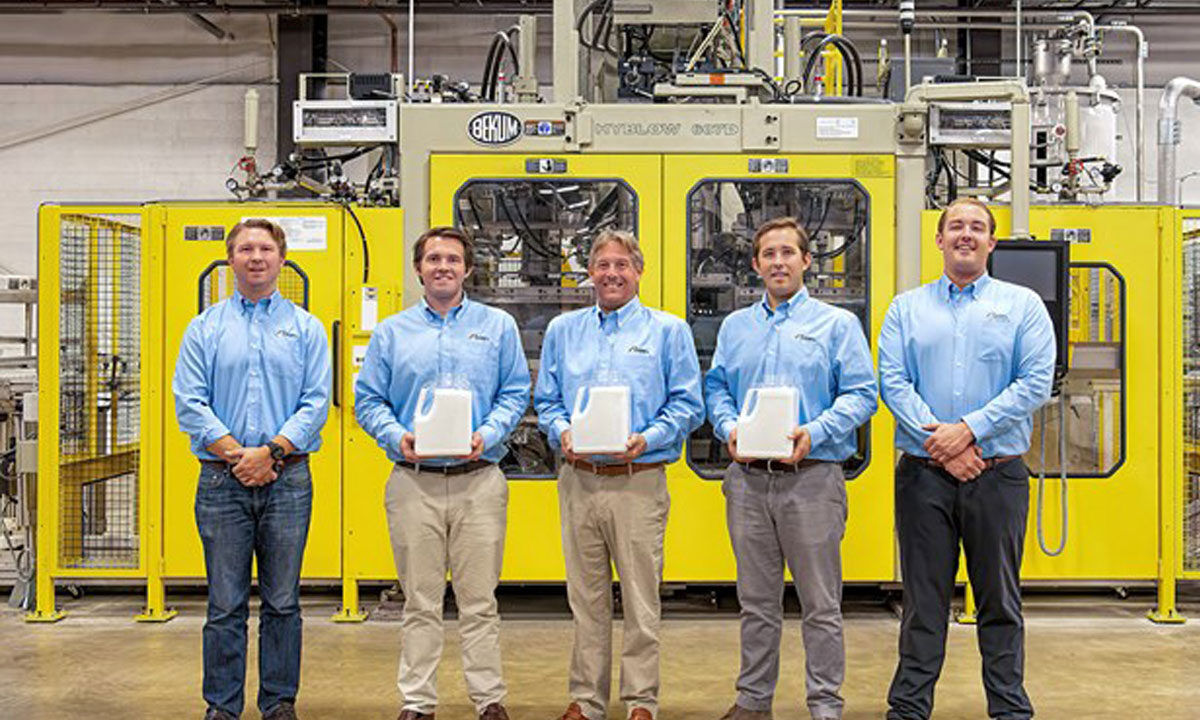
You’ve probably heard of molders that start out in high-volume commodity products and then diversify to take on more high-tech, engineered custom applications. What you may not have encountered is a molder that does the reverse—starting from a base in highly engineered, lower-volume products and then expanding into high-volume consumer packaging, while retaining the custom focus and high level of customer service that made it successful in the first place.
“We don’t want to become a commodity blow molder. We offer value—customization in design, packaging and labeling.”
That’s the evolving strategy of The Flexcraft Co., a custom blow molder headquartered in Neptune, N.J. To accomplish this, the firm has invested in a broader arsenal of blow molding technologies, as well as automation and employee development. Ben Smith, CEO, explains the strategy: “We don’t want to become a commodity blow molder. We’re not looking to the be the cheapest option. We offer value—customization in design, packaging and labeling. We’re a regional blow molder, so we offer freight savings to local clients. We’ve invested so much in our people and technical capabilities—more than $15 million in new equipment since 2015. We can offer what the larger guys do, but customer service is where we shine. We react fast. As we’ve grown, we have stayed true to the importance of every customer.”
That growth has indeed been impressive: around 20% annually for the past five years. This was accomplished without a full-time sales force. “We’ve grown by word of mouth and reputation,” says Smith. “Our customers’ engineers get to know us, and when they move to new companies, they recommend us as a supplier. We make things easy for them—offering engineering, tooling, molding and secondary operations like surface treatment, printing, sleeving, labeling and more.”
Flexcraft was founded in 1971 by the late George Smith together with his son Russ Smith Sr. George was a former GE Plastics engineer who hankered to make products from the resins he had spent his career developing. The Smiths bought a chocolate extruder from Hershey and converted it to a blow molding machine. For their first customer, they molded thick-walled polycarbonate and polysulfone vacuum canisters for medical equipment. Flexcraft still molds for that customer today.
Starting with a converted chocolate extruder, the firm now has two plants with 150 employees and around 40 injection and blow molding machines.
Over the next 25-30 years, Flexcraft built a reputation as a highly technical blow molder for medical and biosciences applications. In 1980, the firm tackled a large metal-to-plastics conversion project, replacing 18 stainless-steel parts with a single polysulfone blow molded component. In 1985, Flexcraft claimed credit for being the first to extrusion blow mold Allied-Signal’s Halar ECTFE (now supplied by Solvay) and, in 1989, the first to blow mold GE’s Ultem PEI (now supplied by SABIC).
In 2015, Russ Sr.’s four sons acquired the company (flexcraft.com) and moved it to the 210,000-ft2 Neptune City plant, which today employs 150 people. Besides Ben Smith as CEO, the firm is operated by his brothers, Russ Jr, president and CFO; Dan, COO; and Tucker, program manager. Dan and Tucker run the factory floor.
For most of the last two decades, the firm has invested aggressively in technology and capacity expansion—continuing right through the COVID-19 pandemic:
• In 2015 Flexcraft made its first major investment in injection stretch-blow molding (ISBM) of PET.
• In 2016-18 came five more Bekum extrusion blow machines, each with fully automated material handling.
• In 2017 the firm brought on an IQMS MES/ERP computer system for production management.
• 2020 saw completion of a two-year project with Bekum to develop a large machine for the burgeoning field of extrusion blow molded PET, or EPET (see Jan.’19 Close-Up.) That year also brought in two more Bekum machines, plus an expansion of the cleanroom molding area, addition of a 50,000 ft2warehouse, and automatic bagging and palletization on two molding lines.
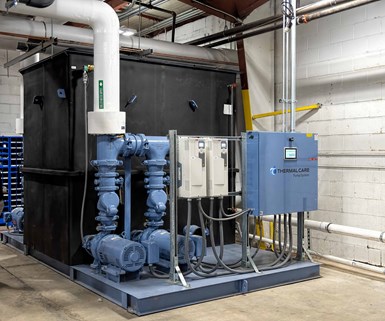
A new 500-ton central chiller will support a future tripling of machine capacity, but variable-frequency drive continuously tailors the energy consumption to the immediate load. Large customers are said to be looking for such sustainability measures from their suppliers.
• So far this year, Flexcraft has made two significant additions. One is a sophisticated 500-ton central chiller system from Thermal Care. It’s large enough to support a future tripling of current machine capacity; but thanks to variable-frequency drive (VFD), the system uses only as much energy as the plant needs at any point in time. “That’s very important,” notes Smith. “A couple of large customers are looking for sustainability efforts by their suppliers.” The second key purchase is plant-wide air conditioning. “It provides a better work environment, and humidity changes can affect the molding process a lot,” says Smith.
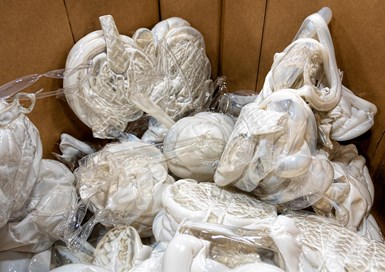
Another effort toward sustainability is Flexcraft’s plan to reuse every bit of its internal scrap, much of which is reground and reused at the press. A new shredder will allow purgings such as these to be reclaimed, too.
This year, Flexcraft also enhanced its ability to recycle internal waste. Trim scrap is already reground and blended at the molding machines; a brand-new shredder allows reclaiming purgings, too. “Our goal is to reprocess 100% of our scrap within the next three years,” notes Smith. He adds, “We’ve been using a lot of HDPE post-consumer reclaim for going on six years, but right now there’s a crazy shortage of PCR availability and extreme volatility in pricing.” He says the firm is also looking into additives that make PE and PP biodegradable. “We see the demand coming, and we want to be ready—to know we can process it.”
Plans for capacity expansion continue apace. A former toolroom space is being converted to make room for four more blow molding machines. One additional Bekum machine cell with automated material handling was purchased, and a second ISBM machine is on order. A 12,000-ft2 cleanroom expansion is nearly complete, and the first machine to occupy it was due to arrive as this article went to press.
Flexcraft has also grown through acquisitions. In 2003 and 2005, it absorbed two smaller blow molders, gaining new customers and some additional machines. In 2019, Flexcraft purchased another blow molder active in similar high-tech custom markets, Blow Molded Specialties in Pawtucket, R.I., whose 30,000-ft2 plant with 40 employees is now operating as a second Flexcraft facility. “This acquisition helped build our technical depth and provided additional cleanroom molding capacity,” says Ben Smith. “It also helped us to diversify our customer base in medical and specialty products. They have experienced people and the same basic operating philosophy and capabilities as us. But they have smaller machines, which are good for smaller parts with tight tolerances.” (See PT’s May ’13 profile of Blow Molded Specialties.)
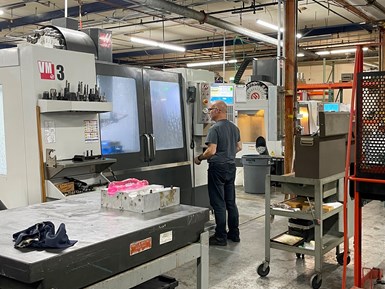
Flexcraft bought a blow-mold maker to give it in-house control over complex, tight-tolerance jobs that require multiple tool revisions.
In 2010, Flexcraft made a different sort of acquisition—Primus Mold in Middlesex, N.J., a maker of blow molds. “We wanted in-house mold manufacturing,” Smith explains, “because a lot of our programs, especially tight-tolerance jobs, require multiple mold trials and tooling adjustments. We need flexibility to try new ideas ‘outside the box.’ This way, we can dictate the shop schedule.” Flexcraft now has six people dedicated to the toolroom, which builds about 10% of the company’s molds and also performs maintenance and repairs and builds downstream automation equipment.
Flexcraft in New Jersey currently has 18 extrusion blow molding machines, 13 of them continuous-extrusion shuttles from Bekum, plus one single-stage ISBM machine from Nissei ASB Co. The Rhode Island plant has 14 extrusion blow machines built by Rocheleau.

CEO Ben Smith displays a large Styrolux “Bottle Bank” piggybank that has been blow molded on an accumulator head for more than a decade but will be transitioned to a continuous-extrusion process.
The headquarters plant also has five older Hayssen accumulator-head machines, which are being phased out. Flexcraft has worked with Bekum to learn how to convert the larger parts made on the accumulator machines to run with continuous extrusion. An example is a large piggybank shaped like a classic Coca-Cola bottle and made of Styrolux styrene-butadiene copolymer from Ineos Styrolution. Flexcraft has made the “Bottle Bank” on accumulator-head machines for 13 to 14 years, but will be switching it over to continuous extrusion.
Also in New Jersey are six injection molding machines of 35 to 310 tons, used to mold caps, closures and other packaging components.
“We wanted in-house mold manufacturing because a lot of our programs, especially tight-tolerance jobs, require multiple mold trials and tooling adjustments.”
Since its founding, Flexcraft has been devoted mainly to complex parts for medical and biosciences, often using engineering resins. Examples of current applications in that field include custom diagnostic reagent bottles, PC vacuum chambers for medical equipment, large flasks of PC and EPET for COVID vaccine production, a flexible TPE pump for bariatric surgery, and a TPE inflatable medical device.
EPET is another area of custom packaging where Flexcraft sees opportunity. Its multimillion-dollar development program with Bekum resulted in a version of Bekum’s model 607D with an oversized extruder capable of molding large, wide-mouth EPET containers in up to four cavities. Flexcraft’s first project in this area is a 160-oz jug with integral handle, designed to hold large quantities of dried spices used in restaurant kitchens. It is blow molded with a dome that is cut off to yield a very wide neck. The product is being converted from PVC to EPET, which is regarded as a more sustainable solution.
Looking ahead, Smith foresees adopting coextrusion for personal-care packaging, where cost savings can be achieved by using only a thin external layer of colored resin over a virgin internal layer.
Smith voices a complaint heard widely throughout the industry: “There’s a massive labor shortage, and it’s even worse in technical personnel.” Flexcraft is addressing that on two parallel tracks. On the one hand, says Smith, “We want to use automation to minimize the human element that can cause variation.” Almost all lines have fully automated material handling, and the toolroom has built several items of downstream automation, such as trim-and-transfer tooling that orients bottles upright on conveyors, and a box filler that counts bottles packed and indexes the box when it reaches a preset count.
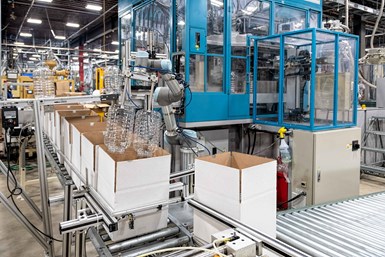
The company’s second ISBM machine is on order to take advantage of what is seen to be major growth potential in oriented PET bottles. Here, large, wide-mouth bottles are packed upside-down, a potentially labor-intensive task that is now handled by a cobot.
For a new EPET application that requires large bottles to be packed upside down, Smith says the labor requirement was especially large, so the job was automated with a collaborative robot (“cobot”) from Universal Robots.
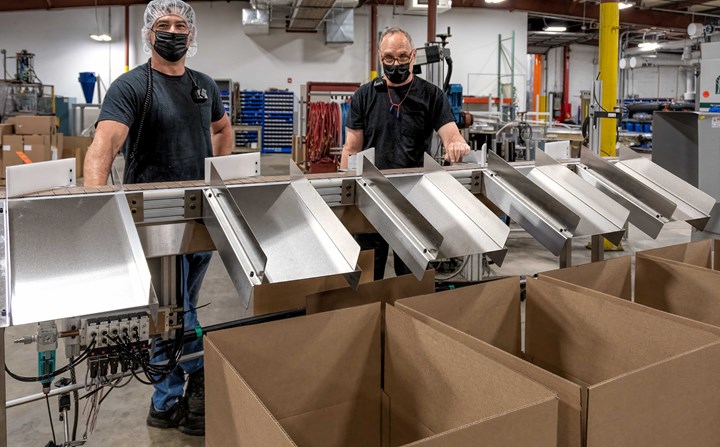
A new Automation group focuses on making processes more consistent. Team members Adrian Mendez, technical manager (l.), and Kevin Izworski, plant engineer, design and build devices like this indexing box filler.
While automation can free people from simple, repetitive tasks, Flexcraft is also working to develop its personnel for more challenging activities. “We want to help people build careers in molding,” explains Smith. “So this year, we made a massive investment in a complete Paulson Training package for injection and blow molding. It will allow us to track employees’ progress through the program. And we are transitioning one person into a full-time trainer.”
Tags: